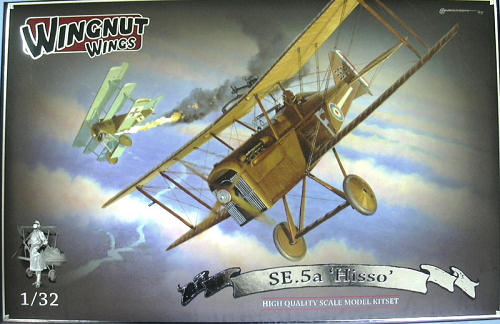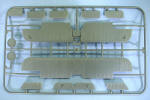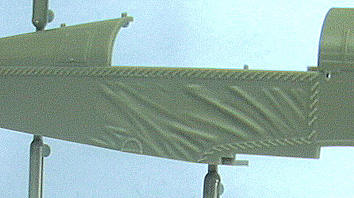
| KIT #: | 32003 |
| PRICE: | $59.00 SRP |
| DECALS: | Five options |
| REVIEWER: | Tom Cleaver |
| NOTES: | New mold kit |

| HISTORY |
The Royal Aircraft Factory S.E.5a was, with the Sopwith
Camel, one of the two best British fighters of the First World War.
It first appeared in the Spring of 1917 as the S.E.5,
powered by the 150 h.p. V-8 Hispano-Suiza 8Aa.
This turned out to be underpowered, and by that summer
the S.E.5a - powered by the 200 h.p. Hispano-Suiza 8Ab “Hisso” and featuring
wings of shorter span - appeared.
The Hispano-Suiza was unreliable mechanically, and the
S.E.5a appeared throughout the rest of the war powered by either the geared
Hispano-Suiza engine or various “clones” from Wolseley, with a final development
from Wolseley known as the “Viper,” featuring “direct drive,” which solved most
of the engine problems.
Whether the engines were produced by Hispano or Wolseley,
geared engines were known as “Hisso” and direct drive engines as “Viper.”
The S.E.5a equipped many of the leading RAF squadrons,
as well as two squadrons of the American U.S.A.S.
Like the P-47 in the Second World War, the S.E.5a’s
pilots had the highest survival rate of any fighter.
| THE KIT |
 Wingnut Wings is a company that is backed financially by
well-known film director and World War I aviation enthusiast Peter Jackson.
The company seeks to release kits that are of high
quality and technical accuracy, while being easy to assemble so as to attract
modelers who have been previously put off the idea of building biplanes.
The technical sources include original factory drawings
and access to the 1:1 airframes that have been built by Jackson’s company, The
Vintage Aviator, which are known as the most accurate replicas ever made.
Wingnut Wings is a company that is backed financially by
well-known film director and World War I aviation enthusiast Peter Jackson.
The company seeks to release kits that are of high
quality and technical accuracy, while being easy to assemble so as to attract
modelers who have been previously put off the idea of building biplanes.
The technical sources include original factory drawings
and access to the 1:1 airframes that have been built by Jackson’s company, The
Vintage Aviator, which are known as the most accurate replicas ever made.
 This kit, the third of the first four in the initial
release, comes on four sprues of medium-grey plastic (one full sprue shown
as a sample. Ed), and is crisply molded with separate control surfaces.
The fabric detail includes wing and
This kit, the third of the first four in the initial
release, comes on four sprues of medium-grey plastic (one full sprue shown
as a sample. Ed), and is crisply molded with separate control surfaces.
The fabric detail includes wing and
 tail rib
tape with the stitching detail under the tape.
Two different fuselages are included, one with “taut”
fabric and one with the “wrinkled” fabric seen on various S.E.5as and never
before done on any plastic kit. The cockpit has lots of small detail. Decals are
by Cartograf for five different aircraft and are accurate as regards the colors
of the national markings (a small but important matter many decal makers have
had trouble with).
tail rib
tape with the stitching detail under the tape.
Two different fuselages are included, one with “taut”
fabric and one with the “wrinkled” fabric seen on various S.E.5as and never
before done on any plastic kit. The cockpit has lots of small detail. Decals are
by Cartograf for five different aircraft and are accurate as regards the colors
of the national markings (a small but important matter many decal makers have
had trouble with).
Others have rightly lauded the instructions. The 22-page booklet has many period photos as well as detail photos of the 1:1 scale S.E.5a owned by Peter Jackson. Photos of the machine guns are also provided for detailing. One thing I particularly like is the fact there is information there I did not know previously about the S.E.5a, such as the fact that the Sutton harness was only used on late-production S.E.5a’s.
| CONCLUSIONS |
There has been an attitude on the part of many modelers
that these kits from Wingnut Wings are some form of “second coming” that makes
all other 1/32 World War I kits obsolete.
As with most reports of the “second coming,” this is not
true.
I happen to have both the Wingnut Wings S.E.5a and the
kit from Roden here, and have taken the opportunity to do a comparison of the
two.
As regards surface detail, the two kits are different,
reflecting a different philosophy on the part of the kit designers.
In fact, on a full-scale fabric-covered airplane, the
rib tapes are not really obvious unless the angle of the sun is such that it
etches the tape. They’re really about as visible as rivets on a flush-riveted
airplane. The rib tapes on the Wingnut Wings kit are “overdone” but then most
surface detail on most plastic kits is overdone.
The Roden wings are done with more subtlety and are thus
more “technically accurate.”
Whether one likes one choice over the other is strictly
a personal aesthetic choice.
The fuselage on the Wingnut kit does provide the
“wrinkles” that have never been done before.
This isn’t completely accurate, but is probably as
accurate as can be done in injection plastic and will likely look very nice
under a coat of paint.
One thing that those suffering from detail OCD will
notice is that the wrinkles aren’t on the inside, but this would be impossible
(I think) in molding the parts.
The other fuselage is “taut” fabric which is very plain.
Here, the Roden kit shows a more subtle approach, with
slight “dips” in the fabric between the frames of the fuselage structure.
These are so subtle one will only see it when the model
is painted and under certain lighting.
The Wingnut kit has the control surfaces separate, which
certainly eases construction if you - like me - want to do your World War I
model with the surfaces posed dynamically.
The Roden kit has these molded integral to the rest of
the wing or tail, and thus they have to be cut off and shaped before being glued
in position; this is not difficult to do.
The Wingnut kit has more detail in the cockpit, but the
Roden kit looks good when assembled.
The Roden kit needs seatbelts, whether the early lap
belt or later Sutton harness is used, while the Wingnut kit has the early lap
belt, and would need the Eduard Sutton harness also.
Overall, these kits are similar but different, in the
same way that Eduard 1/48 kits and Roden 1/48 kits of the same subject are
similar but different.
The Wingnut kit may be easier to assemble, since there
has been effort put into the design to make it “click fit” and thus prevent mis-assembly.
Given that World War I kits by their nature are going to
attract modelers with some experience to begin with, this factor is nice but not
essential.
Overall, the Wingnut kit does not make the Roden kit “obsolete” any more than the Eduard kits did. Wingnut is to be commended for creating kits that are attracting modelers to the genre, and their list of coming releases includes airplanes I never ever thought I would see in this scale. Like the Roden kits, these Wingnut kits prove the truth of my thesis that 1/32 is the ideal scale for World War I models.
May 2009
Thanks to Wingnut Wings for the review kit.
If you would like your product reviewed fairly and quickly, please contact me or see other details in the Note to Contributors.